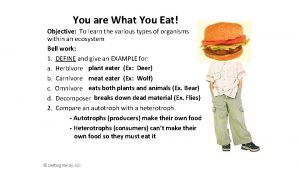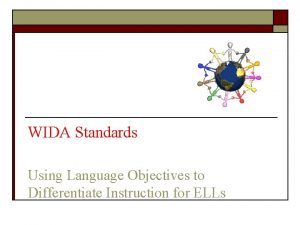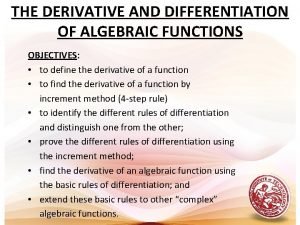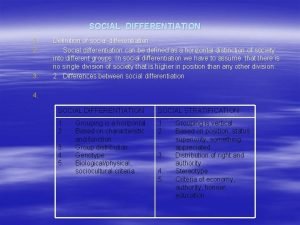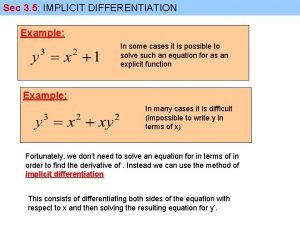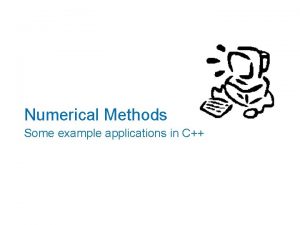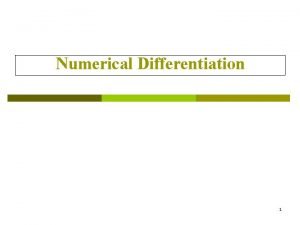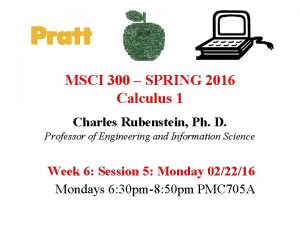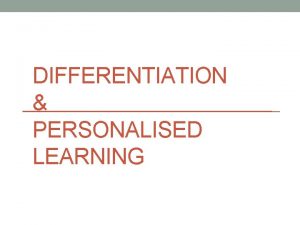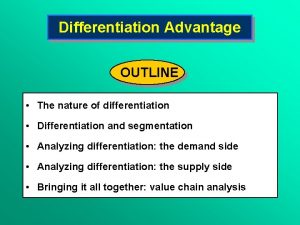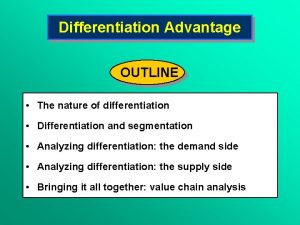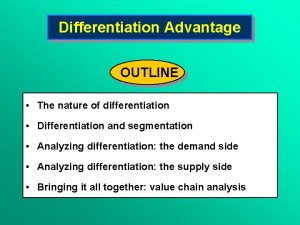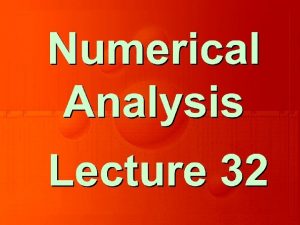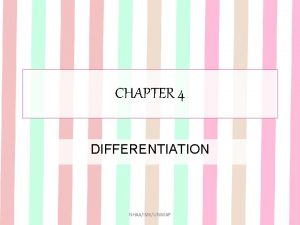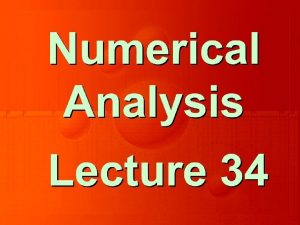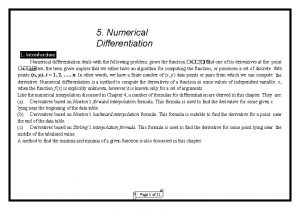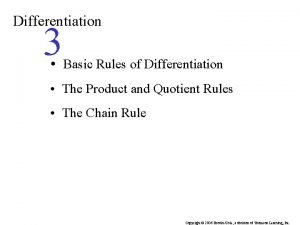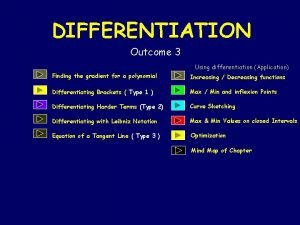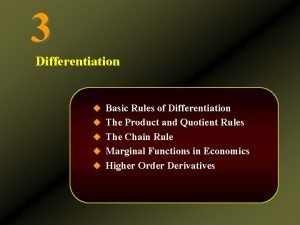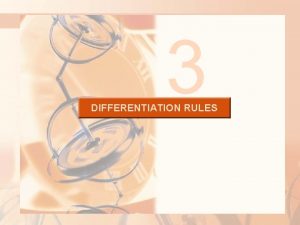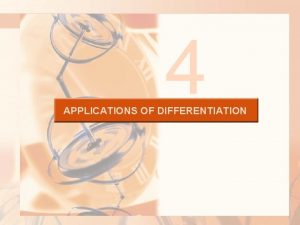Introduction You will learn what Differentiation is You




























- Slides: 28


Introduction • You will learn what Differentiation is • You will see how to apply it to solve graph based problems • It is one of the single most important topics there is in Maths!


Differentiation You need to be able to find the gradient function of a formula Straight Line = Constant Gradient On a straight line graph, the gradient is constant, the same everywhere along the line. On any curved graph, the gradient is always changing. Its value depends on where you are along the x-axis. tangent The different gradients can be shown by tangents. These are lines that touch the curve in only one place. Curved line = Gradient Changes Differentiation is the process whereby we can find a formula to give the gradient on a curve, at any point on it. tangent 7 B

Differentiation You need to be able to find the gradient function of a formula As a general rule, if; Examples Find the derived function of each of the following… a) f(x) = x 3 This is the formula for the curve, ie) the function f’(x) = 3 x 2 b) f(x) = 2 x 2 f’(x) = 4 x 1 (4 x) then… This is the gradient function for f(x). The formula that gives the gradient at any point. Its is also know as the derivative, or ‘derived function’ c) f(x) = x-2 f’(x) = -2 x-3 d) f(x) = -3 x-3 f’(x) = 9 x-4 7 B

Differentiation You need to be able to find the gradient function of a formula As a general rule, if; Examples Find the derived function of each of the following… e) This is the formula for the curve, ie) the function then… This is the gradient function for f(x). The formula that gives the gradient at any point. Its is also know as the derivative, or ‘derived function’ f) Must be written in the form axn first! 7 B


Differentiation You need to be able to solve Graphical problems using the Gradient Function Remember that differentiating gives us a formula for the gradient at a given point on the graph (x). A standard question will ask you to work out the gradient of a curve at a particular point. This is when differentiating is used. Examples a) Calculate the gradient of the curve f(x) = x 2 where x = 3 Differentiate to get the gradient function Substitute in the value for x at the required point b) Calculate the gradient of the curve f(x) = x 2 at the coordinate (-2, 4) y = x 2 Differentiate to get the gradient function Substitute in the value for x at the required point 7 C

Differentiation You need to be able to solve Graphical problems using the Gradient Function Examples c) Find dy/ dx when y equals x 2 – 6 x - 4 Differentiate each term separately. Remember that differentiating gives us a formula for the gradient at a given point on the graph (x). A number on its own disappears A standard question will ask you to work out the gradient of a curve at a particular point. This is when differentiating is used. This also means the gradient function 7 C

Differentiation You need to be able to solve Graphical problems using the Gradient Function Remember that differentiating gives us a formula for the gradient at a given point on the graph (x). A standard question will ask you to work out the gradient of a curve at a particular point. This is when differentiating is used. Examples d) Find dy/ dx when y equals 3 – 5 x 2. Differentiate each term separately. A number on its own disappears 7 C

Differentiation You need to be able to solve Graphical problems using the Gradient Function Remember that differentiating gives us a formula for the gradient at a given point on the graph (x). A standard question will ask you to work out the gradient of a curve at a particular point. This is when differentiating is used. Examples e) Let f(x) = 4 x 2 – 8 x + 3. Find the gradient of the curve y = f(x) at the point (1/2, 0) Differentiate to get the gradient function Substitute in x = 1/2 7 C

Differentiation You need to be able to solve Graphical problems using the Gradient Function Examples f) Find the coordinates when the graph y = 2 x 2 - 5 x + 3 has a gradient of 7. Remember that differentiating gives us a formula for the gradient at a given point on the graph (x). A standard question will ask you to work out the gradient of a curve at a particular point. This is when differentiating is used. Differentiate to get the gradient function The gradient is 7 at the point we want Add 5 The x coordinate where the gradient is 7 has a value of 3. Substitute this into the ORIGINAL function to find the ycoordinate So the graph has a gradient of 7 at (3, 6) Divide by 4 7 C

Differentiation You need to be able to solve Graphical problems using the Gradient Function Examples Remember that differentiating gives us a formula for the gradient at a given point on the graph (x). Set the equations equal to each other (to represent where they meet) A standard question will ask you to work out the gradient of a curve at a particular point. This is when differentiating is used. g) Find the gradient of the curve y = x 2 where it meets the line y = 4 x - 3 Group on the left Factorise The lines will meet at (3, 9) and (1, 1) by substitution. At (3, 9) the gradient will be 6 (by putting ‘ 3’ into the gradient function) At (1, 1) the gradient will be 2 (by putting ‘ 1’ into the gradient function) Differentiate y = x 2 to get the gradient function 7 C


Differentiation You need to be able to deal with much more complicated equations when differentiating Remember as before, all terms must be written in the form axn before they can be differentiated. It is useful to note that at this stage, being able to rewrite in this way is not essential. However being able to switch between forms will be very useful on harder questions. Examples Differentiate the following: a) Rewrite in the form axn Differentiate Factorise Being able to do this now is worth practising as you will definitely need it on C 2/3/4! 7 E

Differentiation You need to be able to deal with much more complicated equations when differentiating Remember as before, all terms must be written in the form axn before they can be differentiated. It is useful to note that at this stage, being able to rewrite in this way is not essential. However being able to switch between forms will be very useful on harder questions. Being able to do this now is worth practising as you will definitely need it on C 2/3/4! Examples Differentiate the following: b) Rewrite in the form axn Differentiate Imagine the term was split apart Rewrite the x term using power rules Group the fractions by multiplying tops/bottoms 7 E

Differentiation You need to be able to deal with much more complicated equations when differentiating Remember as before, all terms must be written in the form axn before they can be differentiated. It is useful to note that at this stage, being able to rewrite in this way is not essential. However being able to switch between forms will be very useful on harder questions. Being able to do this now is worth practising as you will definitely need it on C 2/3/4! Examples Differentiate the following: c) Split into 2 fractions Cancel x’s on the first one Rewrite in the form axn Differentiate Rewrite using power rules Make the Denominators common 7 E


Differentiation You can repeat the process of differentiation to get the ‘second order derivative’ Examples Original Equation or Differentiate once (first order derivative) Rewrite in the form axn Differentiate or Differentiate twice (second order derivative) Differentiate again 7 F

Differentiation You can repeat the process of differentiation to get the ‘second order derivative’ Examples Original Equation or Differentiate once (first order derivative) Rewrite in the form axn Differentiate or Differentiate twice (second order derivative) Differentiate again 7 F


Differentiation You can use differentiation to find the tangent to a curve at a particular point, as well as the normal at that point Normal Remember the curve we have is based on an equation The tangent is a straight line that intersects the curve at on point only. à The gradient of the tangent is the same as the gradient of the curve at the point given (so you can differentiate to get it) Curve Tangent The ‘normal’ is a straight line perpendicular to the tangent where is touches the curve. 7 H

Differentiation You can use differentiation to find the tangent to a curve at a particular point, as well as the normal at that point Find the equation of the tangent to the curve y = x 3 – 3 x 2 + 2 x - 1, at the point (3, 5). So we need the gradient of the tangent. It will be the same as the gradient of the curve at the point given (x = 3) Differentiate to get the gradient function Substitute the x value in to find the gradient The gradient at (3, 5) is 11 Use the formula for a straight line! Substitute the co -ordinate and gradient in Expand bracket Curve Add 5 Tangent 7 H

Differentiation You can use differentiation to find the tangent to a curve at a particular point, as well as the normal at that point Rewrite Differentiate Find the equation of the normal to the curve y = 8 - 3√x at the point where x = 4. Rewrite for substitution àStart by finding the gradient of the curve at that point. Sub in x = 4 Gradient = -3/4 (this is of the tangent) The Normal is perpendicular to the tangent Gradient of the Normal = 4/3 The Gradient where x = 4 is -3/4 7 H

Differentiation You can use differentiation to find the tangent to a curve at a particular point, as well as the normal at that point Find the equation of the normal to the curve y = 8 - 3√x at the point where x = 4. Gradient of the Normal = 4/3 Now we need the co-ordinates at that point. We already have x = 4. Substitute in x = 4 3 times 2 = 6! Use the formula for a straight line! Substitute the co -ordinate and gradient in Multiply by 3 Expand bracket Co-ordinates at the intersection = (4, 2) Rearrange 7 H

Differentiation y = x 2 Showing how differentiation works (sort of!) Multiply the bracket Group some terms This is a lowercase ‘delta’, representing a small increase in x Gradient = change in y ÷ change in x Cancel δx (x+δx, (x+δx)2) (x+δx)2 – x 2 At the original point, δx = 0 x+δx - x (x, x 2)

Differentiation y = f(x) Showing how differentiation works (sort of!) Simplify the denominator This is a lowercase ‘delta’, representing a small increase in x Gradient = change in y ÷ change in x (x+δx, f(x+δx)) f(x+δx) – f(x) x+δx - x This is the ‘definition’ for differentiating a function (you won’t really need this specifically until C 3) (x, f(x))

Summary • We have learnt what Differentiation is, and the process used • We have also seen the appropriate notation • We have also seen when to use it
 Revision techniques for kinesthetic learners
Revision techniques for kinesthetic learners The more you study the more you learn
The more you study the more you learn You live and learn
You live and learn What is a herbivore
What is a herbivore Halvcellsmetoden
Halvcellsmetoden Dlle career project
Dlle career project Learn from ants
Learn from ants Obey the teachers
Obey the teachers Would you rather learn english or french passive voice
Would you rather learn english or french passive voice Tell me i will forget
Tell me i will forget What do you expect to learn
What do you expect to learn Phrases of quantity
Phrases of quantity Today you will learn
Today you will learn Did you learn
Did you learn Wida language objectives
Wida language objectives Difference between udl and differentiation
Difference between udl and differentiation High accuracy differentiation formulas
High accuracy differentiation formulas Differentiate algebraic function
Differentiate algebraic function Porter competitive strategy
Porter competitive strategy Social differentiation definition
Social differentiation definition Ttess personal goals
Ttess personal goals How to find avg velocity
How to find avg velocity Differentiation example
Differentiation example Derivative of 1/x
Derivative of 1/x Delayed differentiation and modular design
Delayed differentiation and modular design Orthogonal unit differentiation
Orthogonal unit differentiation C++ program for numerical differentiation
C++ program for numerical differentiation 1st order derivative formula
1st order derivative formula Reciprocal rule differentiation
Reciprocal rule differentiation



